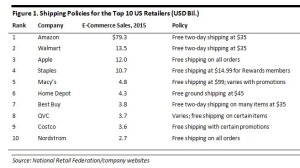In late January, Amazon reduced its minimum purchase requirement for free two-day shipping to $35 ($25 for books) from $50 previously. In an interview with Recode, Marc Lore—who is Walmart’s e-commerce chief and the former CEO of Jet.com, which Walmart acquired last September—made a poker reference when talking about shipping. He commented that “in today’s world of e-commerce, two-day free shipping is table stakes,” referring to the minimum bet required to get in on a poker game.
Amazon’s reduction in its shipping minimum generated a response from Walmart. After having recently eliminated its ShippingPass program offering free two-day shipping in exchange for a $49 annual fee, Walmart, too, began offering free two-day shipping on orders of $35 or more. Due to the timing, Walmart’s move seemed to echo Amazon’s—but perhaps it was Amazon that anticipated Walmart’s move. Interestingly, $35 is also the minimum for free two-day shipping at Jet.com.
While Amazon has offered free two-day shipping to its Prime members, it has largely restricted the benefit otherwise, using it mostly to entice consumers to spend during the holiday season. With giants Amazon and Walmart now both offering free two-day shipping at $35, it appears that any other serious e-tailers need to quickly follow suit.
Amazon’s and Walmart’s recent actions prompt the question “What are other large retailers doing?” To answer that, we have listed the shipping policies for the 10 largest US retailers in the table below.

“Free” Shipping Is Not Free
While shipping may not appear as an added fee to the consumer, it clearly costs money, and that cost is borne by the retailer. Ross McCullough, UPS’s President of Asia Pacific, recently commented to CNBC, “Free shipping has been around, again, since 1996. I used to run an e-commerce team and…there’s no such thing as free shipping.”
The impact of “free” shipping is increasingly showing up on e-tailers’ bottom lines. Indeed, Amazon reported fulfillment costs of $7.1 billion in 2016, up 43% over the prior year, with the growth rate exceeding a 27% revenue increase in the year. Although Walmart reported a substantial, 29% increase in e-commerce sales in its fiscal fourth quarter earnings this week (which includes the benefit from the acquisition of Jet.com last fall), GAAP EPS declined by 14.7% and adjusted EPS declined by 9.2% in the quarter.
Fung Global Retail & Technology will continue to monitor and report on the “shipping wars” among major e-tailers as they continue to heat up.
Other pieces you may find interesting include; From Runway to Checkout, The See-Now-Buy-Now Trend in Fashion, Is Experience Enough? Three Core Functions Will Drive The Future of Retail,
If you like what you are reading, subscribe to our daily news and analysis of retail, technology and fashion here.
Connect with us on social media:
@DebWeinswig
@FungRetailTech
Facebook
LinkedIn
Subscribe to our YouTube channel
Pinterest
Instagram
